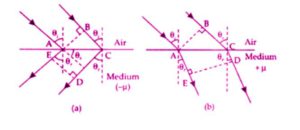The optical properties of a medium are governed by the relative permittivity (εr) and relative permeability (µr ). The refractive index is defined as √µr εr = n. For ordinary material εr > 0 and µr > 0 and the positive sign is taken for the square root. In 1964, a Russian scientist V. Veselago postulated the existence of material with εr < 0 and µr < 0. Since then such ‘metamaterials’ have been produced in the laboratories and their optical properties studied. For such materials n = -√µrεr. As light enters a medium of such refractive index the phases travel away from the direction of propagation. (i) According to the description above show that if rays of light enter such a medium from the air (refractive index =1) at an angle θ in 2nd quadrant, them the refracted beam is in the 3rd quadrant (ii) Prove that Snell’s law holds for such a medium

